
Darin Bird
Alan Wright
Alan Wright
Highfield Moss
Know before you go
Dogs
When to visit
Opening times
Open at all times.Best time to visit
Spring to SummerAbout the reserve
Highfield Moss is a wonderful place to spend a warm summer’s day, particularly if you’re a solitary bee. The nature reserve’s sandy banks are bustling insect cities buzzing with tawny mining bees and buffish mining bees, animating the sand with almost constant movement as they pop in and out of their burrows. You may even be lucky enough to spot the stunning green tiger beetle scrambling up the banks, shining emerald in the sunlight.
This fascinating habitat is all thanks to Robert Stephenson, who dug a railway line right through the middle of this large peatland and left behind sandy banks of spoil. But this isn’t the only thing that makes Highfield Moss unique. It is a lowland raised valley mire: a rare type of wetland for Manchester and an important link in the Great Manchester Wetlands area.
Unique peatland plants like sphagnum moss, carnivorous round-leaved sundew, cross-leaved heath and lousewort grow out on the mire lawns. However, it is marsh gentian that sets Highfield Moss apart. This stunning blue plant is rare right across the UK, and the Moss is a major North West stronghold for these trumpet-shaped flowers.
Of course, such an unusual habitat and unique collection of flora nurtures a thriving insect population that doesn’t just include solitary bees. Heath bumblebees meander from flower to flower, while black darter, common hawker and four-spotted chaser dragonflies zip over tranquil pools, one of which is rumoured to be bottomless!
Emerald damselflies dart around hare’s-tail and common cottongrass, while deep in the vegetation, male meadow grasshoppers serenade the females.
As for birds, you are in for a treat. Whitethroats and linnets sing loudly from the trees and perch on top of coconut-scented gorse bushes, golden plovers potter around on the ground and, up above, birds of prey rule the skies. Buzzards soar serenely overhead, kestrels hover, locked onto prey, and hobbies fly in hot pursuit of dragonflies. Visit at dawn or dusk during autumn and winter and you may even spot short-eared owls quartering the Moss.
